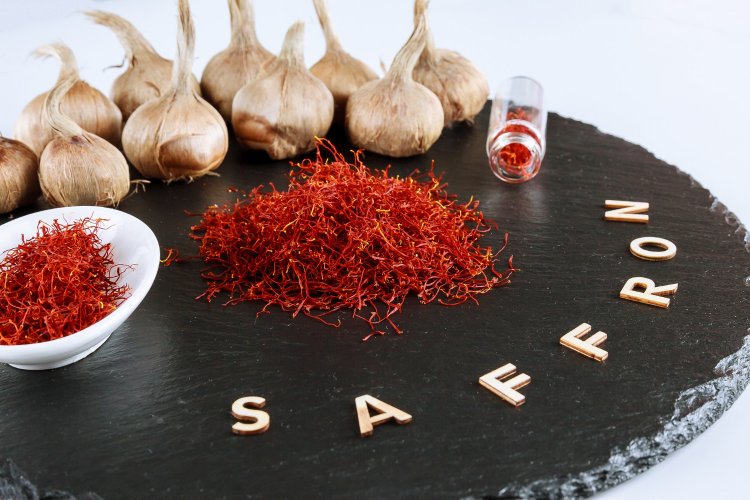Saffron: The Golden Spice
Saffron, often referred to as the "golden spice," stands as one of the most coveted and revered spices globally. Renowned for its striking color, distinct flavor profile, and a plethora of health benefits, saffron holds a cherished place not only in the realm of culinary arts but also in traditional medicine and cultural practices.

History and Origins
The historical narrative of saffron spans millennia, with its origins believed to trace back to the fertile lands of the Mediterranean region, encompassing present-day Iran, Greece, and Turkey. Ancient civilizations, including the Greeks, Egyptians, and Romans, revered saffron for its multifaceted utility, utilizing it not only as a spice but also as a dye, fragrance, and medicinal herb.
Cultivation and Harvesting
Saffron is derived from the stigma of the Crocus sativus flower, commonly known as the saffron crocus. The cultivation of saffron is an intricate and labor-intensive process, necessitating meticulous care and attention to detail. Each delicate flower yields only three crimson stigmas, which must be handpicked with precision. Given that it takes thousands of flowers to produce a mere ounce of saffron, it rightfully earns its title as one of the most expensive spices globally.
Flavor Profile and Aroma
The allure of saffron lies not only in its vibrant hue but also in its distinctive flavor and aroma. Described as floral, with subtle notes of sweetness and earthiness, saffron adds depth and complexity to a wide array of culinary creations. From savory dishes like paella and biryani to decadent desserts such as saffron-infused cakes and ice cream, saffron elevates every dish it graces with its unique sensory profile.
Culinary Uses
Saffron boasts a rich history of culinary applications, spanning various cuisines and dishes across the globe. In Spanish cuisine, saffron takes center stage in the iconic dish paella, infusing the rice with its vibrant color and aromatic essence. Additionally, saffron is a key ingredient in Spanish desserts like saffron-flavored custards and cakes.
In Indian cuisine, saffron is prized for its aromatic properties and is used in a myriad of dishes, including biryanis, kormas, and desserts like kheer (rice pudding) and ras malai (saffron-infused milk desserts). Saffron is also used to flavor beverages such as saffron-infused milk and lassi.
In Persian cuisine, saffron holds a revered status and is often referred to as "red gold." It is a fundamental ingredient in dishes like saffron rice (Chelow), where its delicate aroma and golden hue enhance the flavor of the rice. Saffron is also used in stews (Khoresht) and desserts like Persian saffron ice cream (Bastani Sonnati) and saffron-flavored pastries.
Health Benefits
Beyond its culinary prowess, saffron is revered for its potential health benefits. Rich in antioxidants, including crocin, crocetin, and safranal, saffron may help combat oxidative stress and inflammation in the body. Research suggests that saffron may possess antidepressant properties, offering potential relief from symptoms of depression and anxiety. Additionally, saffron has been studied for its potential role in promoting heart health, improving cognition, and aiding in weight management.
Cultural Significance
Saffron holds profound cultural significance in various regions across the globe. In Iran, saffron symbolizes hospitality, prosperity, and joy, permeating every aspect of Persian cuisine and culture. It is integral to traditional ceremonies, festivals, and celebrations, embodying the essence of Iranian heritage and tradition. Similarly, saffron plays a pivotal role in Mediterranean, Indian, and Middle Eastern cuisines, reflecting its universal appeal and timeless allure.
Sustainability and Conservation Efforts
Despite its illustrious history and economic value, saffron cultivation faces challenges related to sustainability and conservation. Climate change, habitat loss, and water scarcity pose significant threats to saffron-producing regions, necessitating concerted efforts to promote sustainable practices and preserve biodiversity. Initiatives aimed at promoting responsible cultivation methods, supporting small-scale farmers, and conserving natural habitats are crucial for ensuring the long-term viability of saffron production.
In conclusion, Saffron's journey from ancient times to the modern era is a testament to its enduring allure and profound impact on global cuisine and culture. As we continue to appreciate and incorporate saffron into our culinary endeavors, it is imperative to recognize the importance of sustainable practices and conservation efforts in safeguarding its legacy for future generations. In celebrating saffron as the "golden spice," we honor not only its culinary prowess but also its rich cultural heritage and invaluable contributions to human well-being.
#Saffron #GoldenSpice #CulinaryDelight #HealthyEating #FoodCulture #PersianCuisine #MediterraneanFlavors #SustainableFarming #CulturalHeritage
Disclaimer:
The information provided in this article is for educational purposes only and should not be considered medical advice. If you have any health concerns or are experiencing symptoms, it is important to consult with a healthcare professional, such as a doctor or clinic, for proper diagnosis and treatment. Always seek the advice of your doctor or other qualified health provider with any questions you may have regarding a medical condition. Do not disregard professional medical advice or delay in seeking it because of something you have read in this article.
What's Your Reaction?





















